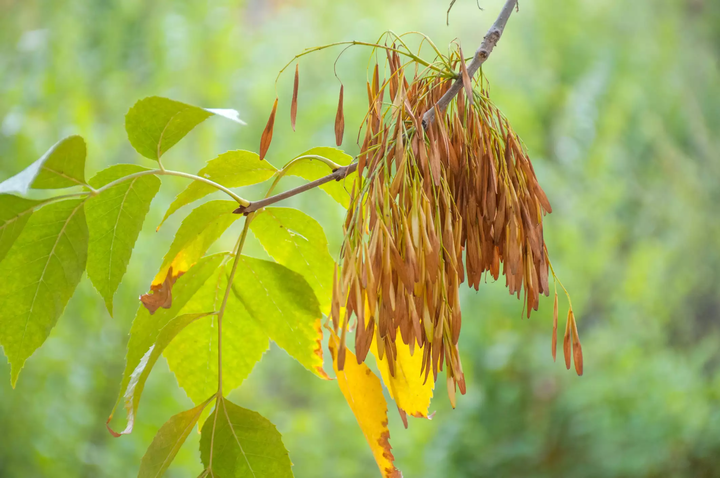Green ash (Fraxinus pennsylvanica) are incredibly hardy, fast-growing, and adaptable deciduous trees that can thrive in almost any habitat in their native North America.
Commonly planted in urban landscapes, they're one of the most popular and prolific ash species. Unfortunately, they're now prone to devasting and fast-spreading emerald ash borer (EAB) infestation.
Warning
Because of EAB, purposefully planting new green ash trees is generally not recommended and is even banned in some regions. You should check your state's regulations, and, even if there are no restrictions on growth, think carefully before you introduce a new green ash to your area. It may end up being subject to removal and could spread the disease to trees situated nearby.
Because of green ash restrictions and the possibility of carrying infestations, seedlings are now not commonly sold in nurseries. It's still possible to buy the seeds as they won't be carriers or ash borer disease.
Green ash trees are closely related to white ash and can be easily confused. Green ash, however, have hairy branches that can help to identify them correctly.
These trees have traditionally been planted in large garden spaces where conditions can make it a challenge for other plants and trees to survive. They develop quickly and can grow over 20 inches in height annually - some have been known to reach 120 feet. Their green leaves also provide interest in the fall when they turn bright yellow.
The leaves on green ash trees are large, and the central stem has numerous lance-shaped leaflets that mean this tree is perfect if you have a sunny garden and you want to create a shady spot. It still lets through enough light for lawns to grow well.
The female trees produce seeds that provide excellent nourishment for birds, but they can be rather messy and weedy. This is why seedless cultivars have grown in popularity.
Botanical Name:
Fraxinus pennsylvanica
Common Name:
Green Ash,
Plant Type:
Deciduous tree
Mature Size:
Up to 60 foot tall
Sun Exposure:
Full sun
Soil Type:
Tolerates a wide range of well-drained soils
Soil pH:
Acidic/neutral
Bloom Time:
Late spring/early summer
Flower Color:
Purple
Hardiness Zones:
3 to 9
Native Area:
North America

How to Grow Green Ash Tree
Green ash prefer well-drained, moist soils and a full sun position. But the reason they have become so popular and, arguably, overplanted is because of their ability to grow in a wide range of conditions.
They can cope with a variety of different soil types, cold winters, periods of drought, wet conditions and urban pollution.
These guidelines will be useful if you already have a young green ash tree growing in your garden. However, given the devastating impact of emerald ash borer, growing from cuttings or seeds is no longer recommended in many areas and could potentially even be illegal.
Light
Green ash prefers to be positioned in a location where they get plenty of sun.
Soil
These trees thrive in moist, fertile soil conditions. They aren't particular when it comes to pH levels, and good growth is possible in loamy, sandy or clay soil types.
Water
If your garden is prone to short periods of flood or drought, your green ash tree is likely to still cope well. They do prefer to be kept consistently moist, but some standing water or dry conditions won't kill this tree off.
Temperature and Humidity
Given their wide-spread growth across the United States, it's no surprise that green ash trees can cope with a wide variance in temperatures. They're known for being impressively cold hardy.
Fertilizer
Young trees benefit from a slow-release fertilizer with decent phosphorous levels. If you have a mature tree already established in your garden, they won't need fertilizing unless they're showing signs of stress.
Propagating Green Ash Trees
Although green ash trees can be easily propagating through bud grafting, seeds or cuttings, this isn't currently recommended given the problems being experienced with emerald ash borer.
Varieties of Green Ash Tree
There are a wide variety of green ash cultivars. Below are a few of the most popular types.
Marshall's Seedless: This is considered the most popular of all the cultivars. It's a seedless variety, isn't as prone to insect problems, and its foliage is known for being strikingly bright yellow in the fall.
Patmore: This is slower growing than most green ash, and it has a more orderly shape.
Cimmaron: Known for its striking red and orange foliage in the fall, this seedless cultivar has branches that grow more laterally than others.
Pruning
Mature trees won't need much pruning. It'll really only be necessary if branches become brittle or diseased, if they have suffered weather damage, or they're growing too wide or tall for the space.
Young green ash will need more pruning to help manage their form.
Common Pests/Diseases
Emerald ash borer (EAB) has been present in the United States since at least 2002 when it was brought over from Asia. It's now recognized as a serious threat to the species. This devastating infestation is caused by the larvae of the Agrilus planipennis beetle. They feed on the tree from the inside and prevent it from being able to carry nutrients and moisture effectively. Typically, an infestation will kill a tree within a few years.
It's thought that adult beetles can fly distances of up to 15 miles and the larvae can stay inside timber cuttings, so the spread has been fast-moving and difficult to eradicate.
If you suspect an existing tree has an EAB infestation, it's best to consult a professional - and quickly. A strict application of pesticides may be able to help, but the situation is more often than not unsalvageable, and the tree may need to be removed.